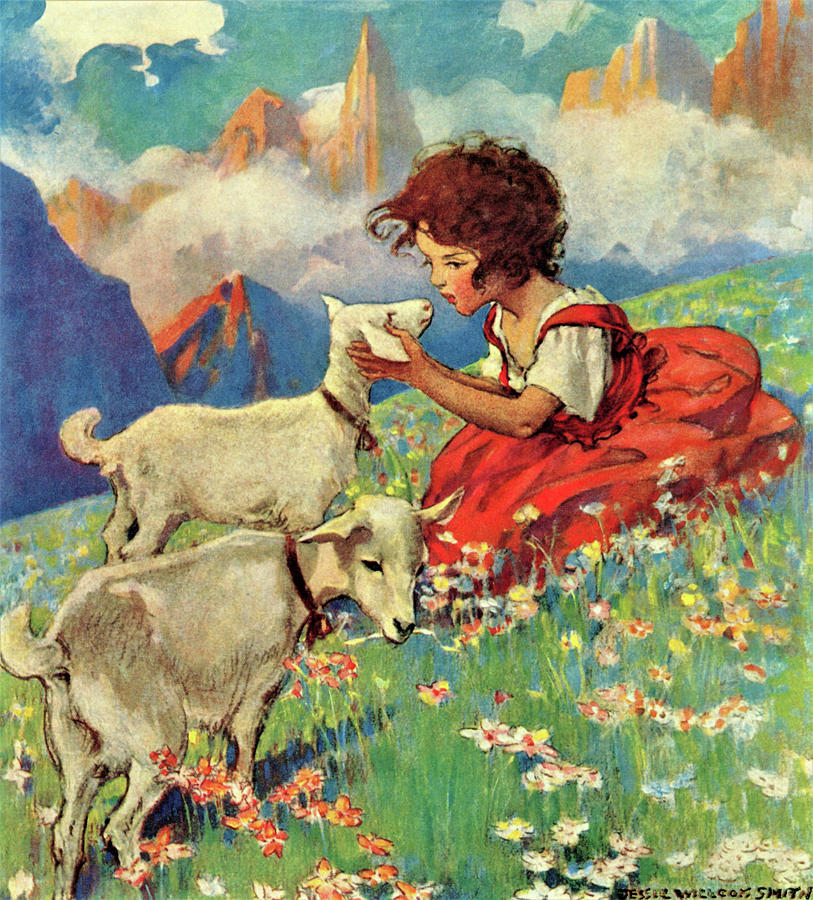Blog Post
How the children’s classics can change your life
By Jonathon Van Maren
One of my favorite things about being a dad is getting to introduce the books I read as a boy to my own children. Just recently, we’ve read through Little House in the Big Woods, Little House on the Prairie, and Heidi with our four-year-old, and with the exception of the moment where Peter the goatherd smashes Clara’s wheelchair, which ruined Charlotte’s evening and made her fiercely wish for horrible things to happen to him, she has loved them as much as we did. But re-reading these classics again, I’ve noticed something: these stories are now artifacts of a different age.
Nearly all of the great children’s classics were written by Christians—cultural or otherwise—for an audience that was either personally or culturally Christian, as well. As Christian practice has become the purview of a shrinking minority, the culture reflected in the children’s classics has become a fundamentally foreign one. This is why abridged versions of these classics (which should be avoided if at all possible) almost always cut out the Christian bits—those are the parts that confuse post-modern readers. The literary butchers carve them down and present us the stories with the soul sliced out.
But as Christian values fade from the public square, classic literature becomes correspondingly more valuable. In a culture awash with degraded entertainment created by storytellers who hate the faith our civilization was founded on, the alternative that many parents seek has been there all along—Anthony Esolen once told me that classics are “the great unused artillery of the culture wars.” These stories are now a beautiful way to buttress any Christian education, with the principles and practices of the Christian life presented to the reader by some of the greatest writers who ever put pen to paper.
Johanna Spyri’s Heidi is one such book. Reading it as a boy, the Christianity that permeates the story seemed natural to me. Of course Heidi prayed before bed. Didn’t all children? It was one of the first things our parents taught us, and we thought this was universal. So effective (and admittedly sheltered) was our upbringing that it was not until years later that I realized the truth—that this was a post-Christian culture, and that nearly everybody, like Heidi’s Alm-Uncle, had long since ceased praying. But unlike the Alm-Uncle, our secular neighbors show no indication of returning to pews abandoned not years, but often generations ago.
Reading Heidi this time around, I wondered if the average Western child today possesses the cultural context to understand the story. The stories and the practices of Christianity were once a second (or even first) language of millions for generations. Now, those stories are virtually unknown and the practices have largely died out. What child today, outside of a handful of Christian enclaves, could understand these words of Heidi: “We must never forget to pray, and to ask God to remember us when He is arranging things, so that we too may feel safe and have no anxiety about what is going to happen.”
Or: “God is good to all of us. He knows what we need better than we do. And just because he thinks it is better not to give you what you want right now doesn’t mean he isn’t answering you. You shall have what you ask for but not until the right time comes.”
Johanna Spryi felt no need to explain these things in depth because she was writing for a culturally Christian society that knew, she could safely assume, what she was talking about even if they had not experienced it for themselves. Spyri herself was a devout member of the Swiss Reformed Church in Zürich (her maternal grandfather was a Reformed pastor.) Without understanding Christianity, Heidi as Spyri intended it is inaccessible. It is not simply the story of a little girl living an idyllic life amidst the Alps; it is the story of a prodigal son (the Alm-Uncle) returning to much rejoicing, and of the essential nature of prayer.
Similarly, the classic American Little House books by Laura Ingalls Wilder not only portray a long-gone pioneer way of life, but also the basic rhythms of a Christian society abandoned even by most modern churchgoers. Growing up, Sunday was the Sabbath. There was church, religious reading, and family time—no shopping, going out to dinner, or other extracurriculars. As stores began to open up for Sunday shopping in the ‘80s, my grandfather tried to shop only at places that remained closed on Sundays and shuttered his own bakery for the day. The experience of attempting to keep the Lord’s Day holy, as Christians have done for more than a thousand years, was familiar to Wilder but foreign to our present culture:
On Sundays Mary and Laura must not run or shout or be noisy in their play. Mary could not sew on her nine-patch quilt, and Laura could not knit on the tiny mittens she was making for Baby Carrie. They might look quietly at their paper dolls, but they must not make anything new for them. They were not allowed to sew on doll clothes, not even with pins.
They must sit quietly and listen while Ma read Bible stories to them, or stories about lions and tigers and white bears from Pa’s big green book, The Wonders of the Animal World. They might look at pictures, and they might hold their rag dolls nicely and talk to them. But there was nothing else they could do.
This Sunday experience would resonate with nearly all previous generations—only in the last half-century has it almost entirely disappeared. What must post-modern readers think of these antiquated traditions that lasted far longer than the pioneer days—but vanished nonetheless?
The Sabbath also plays a key role in my favorite childhood classic, Johann Wyss’s 1812 The Swiss Family Robinson. Wyss, the rector of the Reformed Protestant Cathedral in Bern, wanted to write a story that would teach his children valuable lessons. The Robinsons—a pastor, his wife, and their four sons—are shipwrecked on an uninhabited island teeming with strange and rare creatures, and their adventures as they establish a colony completely captured my childhood imagination. After some time on the island, Father tells his family that they must keep the Sabbath day holy—and because they have lost all track of time, they choose a day for rest, a sermon, Scripture reading, prayer, and family time. Despite the hard work of survival, devotion to God is portrayed as central and as essential as growing crops. Souls and soil must both be tended.
Another example is Anne of Green Gables by Lucy Maud Montgomery. Montgomery grew up in a Presbyterian household, married a Presbyterian pastor, and with her husband, served the St. Paul’s Presbyterian Church in Leaksdale, Ontario while writing books on the parlor couch in the house just down the road (you can still visit, and it is well worth doing so.) Christian values are not the central story of Anne and Green Gables, but again, they are such an inextricable part of the culture that they constantly break through right from the beginning:
“You’ll have to remember a little better if you stay here,” admonished Marilla. “There, that looks something like. Say your prayers now and get into bed.”
“I never say any prayers,” announced Anne.
Marilla looked horrified astonishment.
“Why, Anne, what do you mean? Were you never taught to say your prayers? God always wants little girls to say their prayers. Don’t you know who God is, Anne?”
“`God is a spirit, infinite, eternal and unchangeable, in His being, wisdom, power, holiness, justice, goodness, and truth,'” responded Anne promptly and glibly.
Marilla looked rather relieved.
“So you do know something then, thank goodness! You’re not quite a heathen. Where did you learn that?”
“Oh, at the asylum Sunday-school. They made us learn the whole catechism. I liked it pretty well. There’s something splendid about some of the words. `Infinite, eternal and unchangeable.’ Isn’t that grand? It has such a roll to it–just like a big organ playing. You couldn’t quite call it poetry, I suppose, but it sounds a lot like it, doesn’t it?”
It is particularly jarring to read Louisa May Alcott’s novels in the Instagram age, where appearance is everything, makeup tutorials rack up millions of hits, and image and reality are locked in a depressing dance that wreaks havoc on the mental health of numberless young girls. The virtues of modesty and humility have not been abandoned so much as forgotten entirely. Consider Chapter 9 of Little Women, titled “Meg Goes To Vanity Fair,” a reference to John Bunyan’s Pilgrim’s Progress, in the context of our digital world. It describes Meg’s falling in with a gaggle of girls who determine to make Meg a “fine lady”:
They crimped and curled her hair, they polished her neck and arms with some fragrant powder, touched her lips with coralline salve to make them redder, and Hortense would have added ‘a soupcon of rouge’, if Meg had not rebelled. They laced her into a sky–blue dress, which was so tight she could hardly breathe and so low in the neck that modest Meg blushed at herself in the mirror. A set of silver filagree was added, bracelets, necklace, brooch, and even earrings, for Hortense tied them on with a bit of pink silk which did not show. A cluster of tea–rose buds at the bosom, and a ruche, reconciled Meg to the display of her pretty, white shoulders, and a pair of high–heeled silk boots satisfied the last wish of her heart. A lace handkerchief, a plumy fan, and a bouquet in a shoulder holder finished her off, and Miss Belle surveyed her with the satisfaction of a little girl with a newly dressed doll.
Meg finds it difficult to enjoy her evening, is rebuked by family friend Laurie, and ends up confessing her vanity to her mother and sisters, wracked by guilt. It is a profoundly counter-cultural story—can you imagine attempting to explain to the youth of today how previous generations understood vanity and modesty? Exhibitionism, often online and to countless strangers, is now the norm for young people (and adults, as well.) To try and imagine what Heidi or Anne or the March girls would do with smartphones and Snapchat is to completely obliterate their stories and reshape their lives around these devices. The lives they lived would be nearly impossible with smartphones.
The stories Alcott tells are not just from another time and place, but in our era feel as if they are about a foreign people who saw life and the world around them in ways that made them radically different from us. As Mrs. March told her daughters: “Watch and pray, dear, never get tired of trying, and never think it is impossible to conquer your fault.” But what Mrs. March saw as faults are now just an average day on the Internet—even for those who profess to share her values. What would Mrs. March, or Marilla, or Ma Ingalls think of incessant selfies and constant scrolling? What would those who thought time was inestimably precious think of numberless hours poured into screens far into the night, and the filth too often pouring back?
But the point of this is not just to bemoan the ways our lives have changed in this post-Christian culture, or even the ways our technology has primed and conditioned us to unwittingly imbibe the values of that culture. There are good things about this moment, too—and one of them is that an enormous number of priceless classics containing the goodness, truth, and beauty of times past can be obtained cheaply at any bookstore and nearly all thrift stores. These stories and the lives they portray are not inaccessible to us. Pick up Heidi, or The Swiss Family Robinson, or Little Women–and I could have listed dozens of others, too. It is all still there, waiting to be rediscovered.
***
For anyone interested, here are several interviews I did with those who still remember Laura Ingalls Wilder:









You should check out Mr. Mehan’s Mildly Amusing Mythical Mammals and The Handsome Little Cygnet.
Tried to find this book in local book shop but not available , love to get it for my granddaughter
which one? Little Women?
Do you have a list of classics good for young children? From your site or elsewhere that you can recommend?
Thank you!
I don’t–but I should make a list, actually!